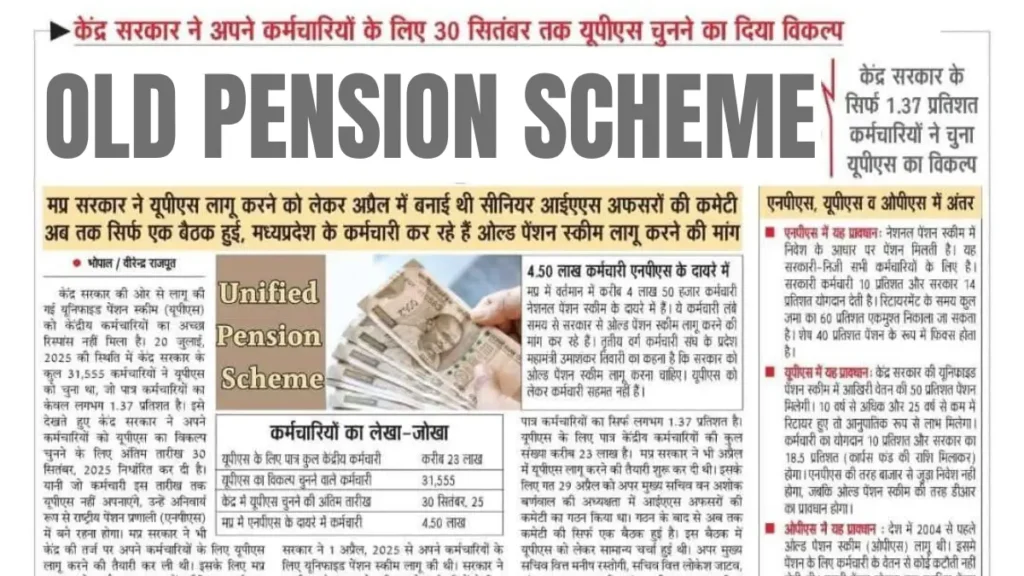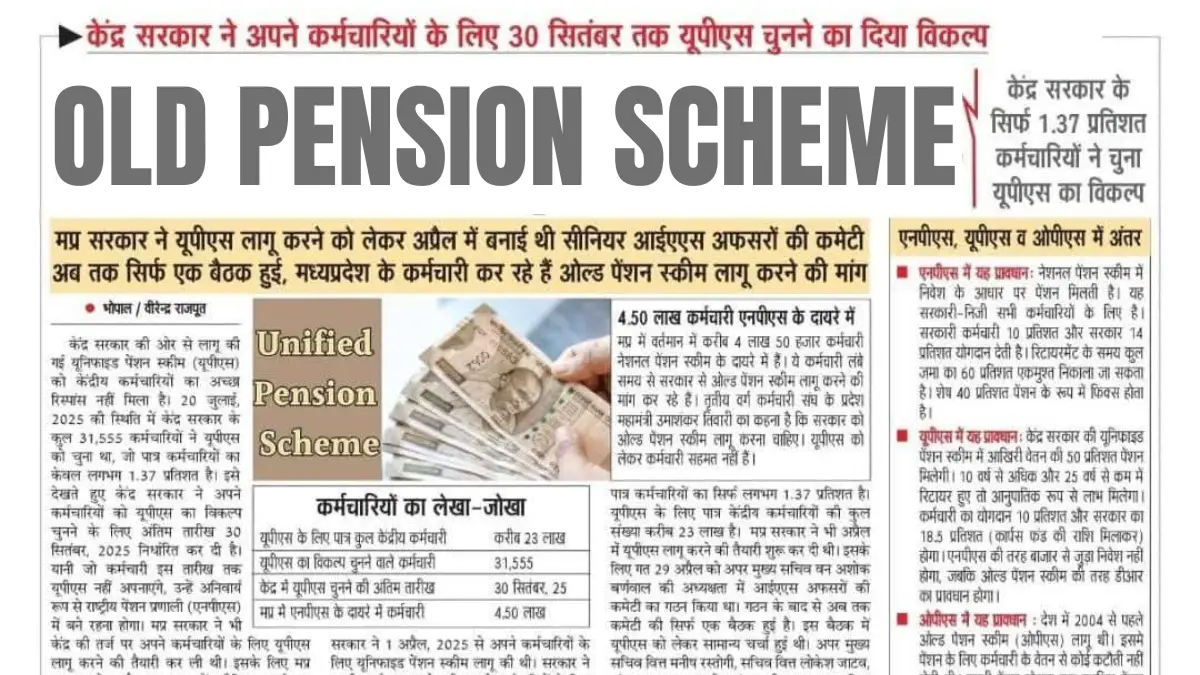Old Pension Scheme 2025 – The Old Pension Scheme (OPS) has long been a point of focus for both retirees and employees in India. Over the years, discussions around pension reforms have gained momentum, with many calling for better financial security for pensioners.
Recently, a significant development has caught the attention of many – the introduction of a ₹10,000 monthly benefit for pensioners under the revamped OPS in 2025. This announcement has stirred hope among retired government employees and those nearing retirement, as it promises to offer a more stable and predictable financial future.

What is the Old Pension Scheme?
The Old Pension Scheme was originally designed to provide government employees with a reliable pension after they retired. The system was based on a defined benefit model, meaning that pensioners would receive a fixed percentage of their last drawn salary each month. The benefit was secure and predictable, offering peace of mind to retirees who could rely on it for their financial needs.
However, in 2004, the New Pension Scheme (NPS) replaced the OPS for most government employees. The NPS, unlike its predecessor, is a defined contribution scheme where pension benefits depend on market performance and the amount contributed during an individual’s working years. This shift led to concerns about the long-term financial security of pensioners, especially since the NPS offers no guaranteed pension, and market fluctuations could reduce payouts significantly.
The Issue with the New Pension Scheme
One of the primary concerns surrounding the NPS is that it doesn’t offer the same level of security as the OPS. In a system like the OPS, pensioners knew exactly how much they would receive every month. In contrast, the NPS ties pension benefits to individual contributions and market returns. This has left many retirees worried about their future financial stability, particularly those whose investment portfolios did not perform well or who didn’t contribute enough during their working years.
Another significant issue is that many pensioners under the NPS are receiving relatively small payouts, especially when considering inflation and increasing healthcare costs. For retirees relying on a fixed monthly pension to cover living expenses, the unpredictable nature of the NPS has created a sense of uncertainty. This situation has only worsened over time, prompting calls for reforms to ensure that pensioners can maintain a comfortable standard of living.
The Introduction of the ₹10,000 Monthly Benefit
In response to these concerns, the government has announced a ₹10,000 monthly benefit for pensioners under the Old Pension Scheme in 2025. This move is seen as a way to provide greater financial security to retired government employees who were previously covered under the OPS or are transitioning back to it. The ₹10,000 benefit is being hailed as a crucial step in addressing the financial challenges faced by pensioners, particularly in an era of rising costs and inflation.
This fixed ₹10,000 monthly payout is designed to offer a stable income for pensioners, removing the uncertainty associated with market-based returns under the NPS. While ₹10,000 may not seem like a massive sum to some, it is a significant boost for many pensioners who have been struggling to make ends meet. This move is expected to provide a safety net for retirees, helping them manage their expenses with more confidence.
The Impact of the ₹10,000 Monthly Benefit
The ₹10,000 monthly benefit is set to have a far-reaching impact on the lives of pensioners. For those who have been receiving low payouts under the NPS, this additional income will provide much-needed relief. The fixed nature of the payment ensures that pensioners will not be exposed to the volatility of the stock market or investment risks, allowing them to plan their finances with greater certainty.
For retirees already receiving pensions under the OPS, the ₹10,000 benefit serves as a valuable supplement to their existing income, helping them cope with the increasing costs of living. With inflation continuing to rise, many pensioners have found it increasingly difficult to make ends meet, and this new benefit will go a long way in easing those financial pressures.
Additionally, the benefit is likely to be adjusted for inflation over time, ensuring that its value remains relatively consistent and continues to support pensioners as the cost of living rises. This makes it a more sustainable solution compared to the NPS, which can result in unpredictable payouts.
Who Will Benefit from the New Scheme?
The ₹10,000 monthly benefit will primarily benefit government employees who were covered under the Old Pension Scheme. This includes employees from various departments and levels of government who had been working under the OPS before it was replaced by the NPS. For these individuals, the new policy offers a lifeline, providing a reliable source of income in their retirement years.
While the scheme has so far been designed to cater to government retirees, there is ongoing discussion about whether similar benefits could be extended to employees of state-run enterprises or private sector workers who may also face challenges during retirement. However, as of now, the focus remains on government employees, and the full scope of eligibility for this benefit is still being defined.
Moreover, it is anticipated that the ₹10,000 benefit will be revised periodically to account for inflation. This will help ensure that pensioners do not face a reduction in the purchasing power of their pension, even as prices for goods and services continue to rise.
The Long-Term Outlook for the Old Pension Scheme
While the ₹10,000 monthly benefit is a promising step, questions remain about the long-term viability of the Old Pension Scheme. The government will need to ensure that it can sustainably fund these increased pension payouts, particularly as the number of retirees grows and more individuals qualify for benefits. Experts suggest that maintaining a balance between offering adequate pension benefits and managing the fiscal health of the country will be a challenge in the years ahead.
To address these concerns, there may be further reforms to the OPS. One possibility is increasing the retirement age to reduce the number of individuals drawing pensions at any given time. Additionally, the government may explore different funding mechanisms or adjust eligibility criteria to ensure the long-term sustainability of the scheme. While the ₹10,000 benefit is a good starting point, these future adjustments may be necessary to ensure that the pension system remains functional in the decades to come.
The Political Dimension of the Scheme
The timing of the ₹10,000 monthly benefit announcement has not gone unnoticed. With elections approaching in several states, many political analysts believe that the government’s decision to restore a form of the Old Pension Scheme is a strategic move to gain the support of retired government employees, a significant voting bloc. Whether the policy is politically motivated or genuinely designed to improve the welfare of pensioners, its potential benefits cannot be ignored.
In the short term, this policy will likely increase goodwill among government retirees, many of whom have felt disenfranchised by the switch from the OPS to the NPS. It is possible that similar policies may be introduced in other states or at the national level, as pensioners are a highly influential demographic.
The Future of Pension Reforms in India
The introduction of the ₹10,000 monthly benefit is only one part of a broader conversation about pension reforms in India. As life expectancy increases and the population of elderly citizens grows, the need for a sustainable and fair pension system becomes even more urgent. The government’s move to enhance the Old Pension Scheme is a recognition of this need and could serve as a model for future reforms.
In the coming years, we may see further innovations aimed at improving the financial security of retirees. These could include integrating digital technology for easier pension disbursements, offering more investment options to increase pension returns, or introducing hybrid systems that combine the best aspects of both the OPS and the NPS.
Conclusion
The ₹10,000 monthly benefit under the Old Pension Scheme represents a major shift in India’s pension landscape. It provides retired government employees with a stable and predictable income, offering much-needed relief to those who have struggled with inadequate pension payouts under the New Pension Scheme. While the long-term sustainability of this policy is still uncertain, it marks a significant step toward addressing the financial challenges faced by pensioners.
As India continues to evolve its pension system, the ₹10,000 monthly benefit could become a cornerstone of broader reforms that seek to provide financial security to all retirees. For now, though, it is a welcome development that offers hope for a better, more secure future for pensioners across the country.
Disclaimer: The information provided in this article is for informational purposes only. The details mentioned are based on current announcements and may be subject to change. Please verify with official sources.
